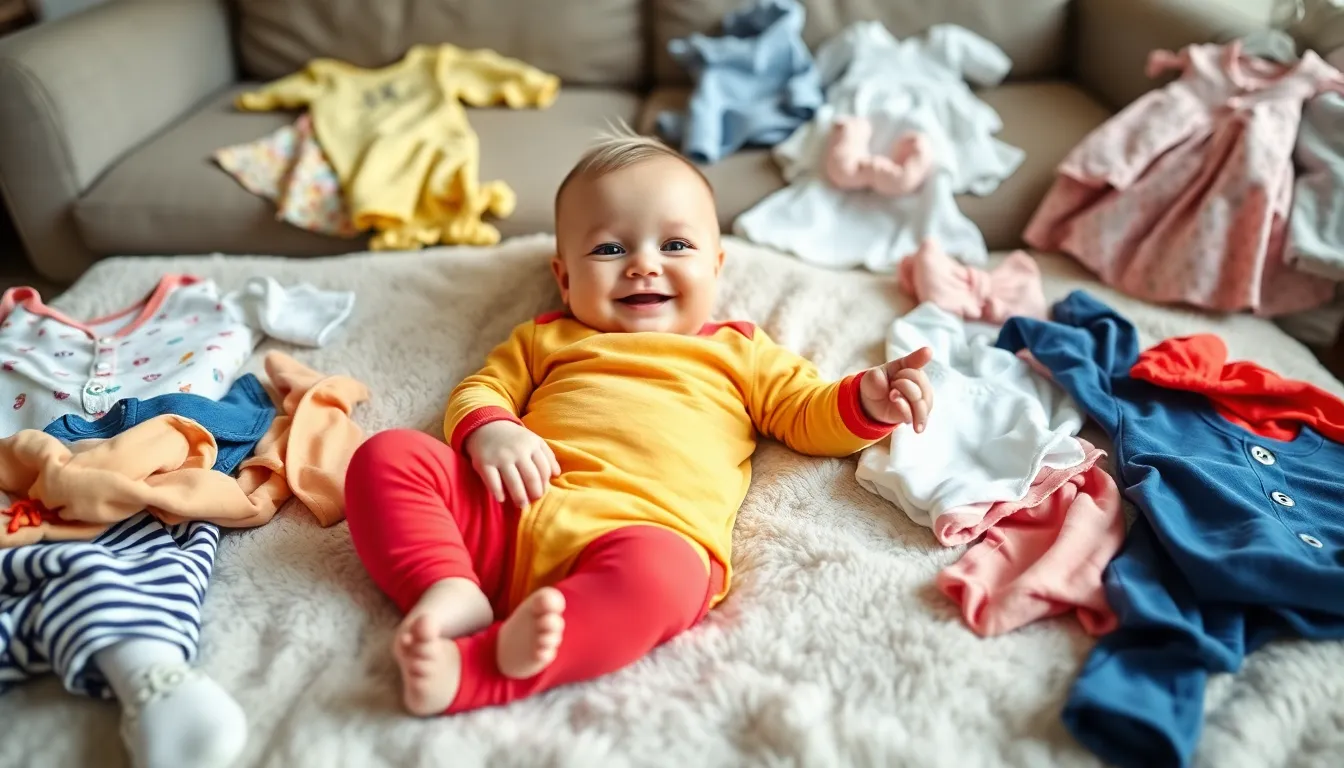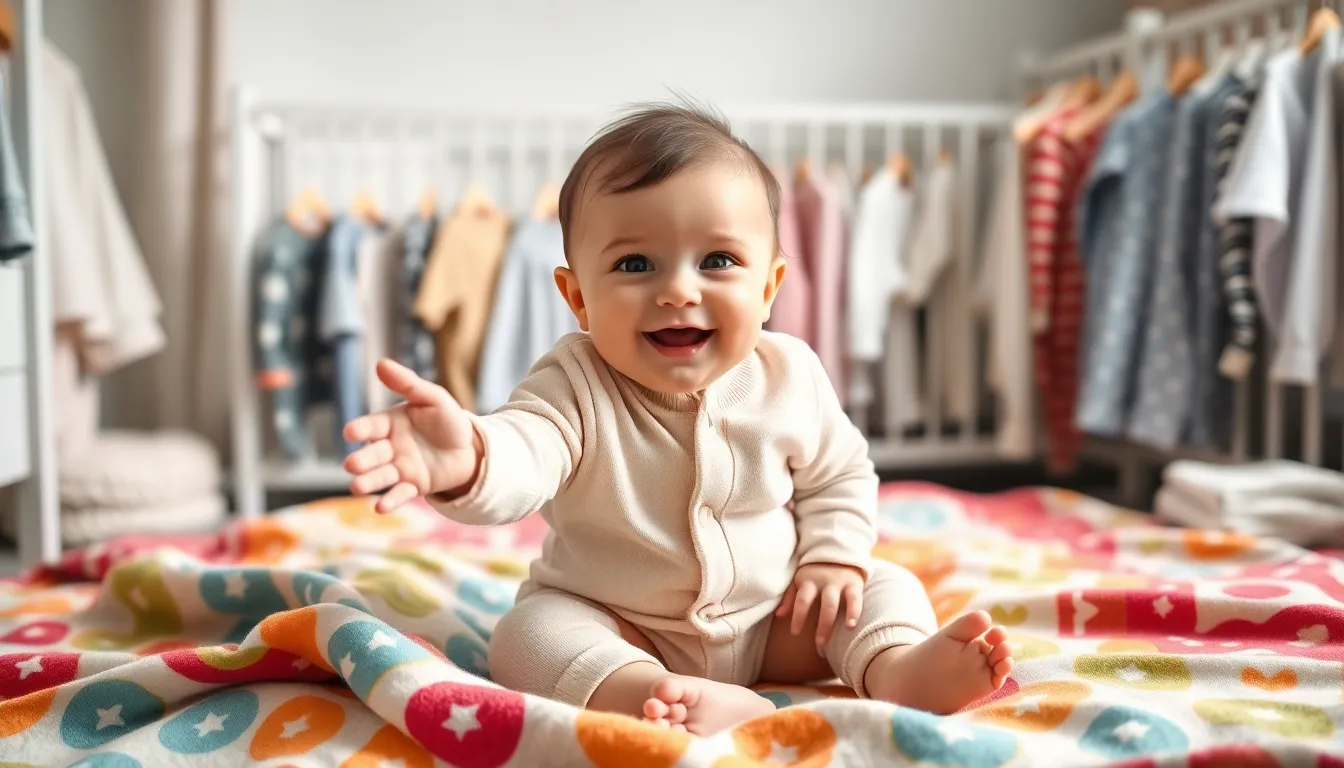Choosing the right baby clothes can feel overwhelming for new parents. With so many options available, it’s essential to find garments that are not only stylish but also comfortable and practical. Babies have sensitive skin and grow rapidly, so selecting the right fabrics and sizes is crucial for their well-being.
From soft onesies to cozy sleep sacks, baby clothes come in a variety of styles and materials. Parents want to ensure their little ones are dressed appropriately for every occasion, whether it’s a family gathering or a quiet day at home. Understanding the key features of baby clothing can help make this important decision easier and more enjoyable.
Table of Contents
ToggleOverview of Baby Clothes
Baby clothes come in various styles and serve multiple functions. Parents require garments that accommodate the delicate nature of infant skin and support rapid growth. Essential clothing items include onesies, sleep sacks, and bodysuits.
Fabric and Comfort
Fabric choices significantly impact comfort and safety. Natural fibers like cotton or bamboo are breathable and gentle on sensitive skin. Avoid materials with harsh chemicals or rough textures, as they can irritate babies.
Size and Fit
Sizing is crucial given infants’ quick growth. Many brands offer clothing sized by age, such as newborn, 0-3 months, or 3-6 months. It’s advisable to select clothing with some room for expansion, ensuring longevity.
Styles for Various Occasions
Parents dress babies for various occasions, necessitating a range of styles. Formal events may call for dresses or tailored outfits, while casual outings might suit comfortable onesies or play clothes.
Seasonal Considerations
Seasonality plays a significant role in clothing selection. Lightweight fabrics are suitable for summer, while heavier materials provide warmth in colder months. Layers are also beneficial for adapting to temperature changes.
Practical Features
Practical features enhance baby clothes’ usability. Snap closures facilitate diaper changes, and stretchy necklines simplify dressing. Clothing should also allow for easy movement to support exploration and play.
By understanding these aspects of baby clothes, parents can make informed decisions that promote comfort, convenience, and style for their little ones.
Types of Baby Clothes

Understanding the various types of baby clothes helps parents choose the most suitable options for their little ones. The selections range from everyday attire to specialized outfits for unique occasions.
Everyday Wear
Everyday wear includes comfortable and functional clothes designed for daily activities. Key items in this category are:
- Onesies: These all-in-one garments offer easy dressing and diaper changes, making them a staple for infants.
- Bodysuits: Bodysuits provide a snug fit and prevent riding up, ensuring comfort throughout the day.
- Sleep Sacks: Designed for overnight wear, sleep sacks offer warmth and security while allowing freedom of movement.
- Leggings: Stretchy leggings complement various tops and allow ease of mobility for crawling and exploration.
- T-shirts: Soft cotton or bamboo t-shirts provide breathability and comfort throughout the day.
When selecting everyday wear, prioritize fabrics like cotton or bamboo that are gentle on sensitive skin and allow for adequate ventilation.
Special Occasion Outfits
Special occasion outfits cater to events like birthdays, holidays, or family gatherings. These garments often feature:
- Dresses: Cute dresses with delicate designs are perfect for formal events, providing charm and elegance.
- Dress Shirts and Pants: These outfits create a polished look for boys at events, often made from breathable fabrics for comfort.
- Bows and Accessories: Accessories like headbands and bow ties enhance the outfit and add a festive touch.
- Footed Suits: These stylish suits can serve as formal wear while ensuring warmth and comfort for baby.
Selecting special occasion outfits involves considering both style and comfort, ensuring the baby feels at ease while looking adorable.
Fabrics and Materials
Choosing the right fabrics and materials for baby clothes influences comfort, safety, and practicality. Parents should consider the benefits of organic and synthetic options when making decisions.
Organic Fabrics
Organic fabrics, such as organic cotton and bamboo, offer numerous advantages for baby clothing. Organic cotton avoids harmful chemicals, ensuring a safe environment for sensitive skin. Bamboo fibers provide softness and breathability, enhancing comfort. Organic fabrics also showcase moisture-wicking properties, keeping babies dry and comfortable. Additionally, these materials are often more sustainable, appealing to environmentally conscious parents.
Synthetic Fabrics
Synthetic fabrics, such as polyester and nylon, also play a role in baby clothing. These materials typically feature durability and resistance to wrinkles and shrinking. They can create moisture-resistant garments, ideal for active babies. However, synthetic fabrics may cause irritation for sensitive skin, so parents should check for any allergies before selecting these options. Blends of synthetic and natural fibers can provide a good balance between comfort and functionality.
Key Considerations When Choosing Baby Clothes
Choosing baby clothes involves critical considerations of size, fit, comfort, and safety. Understanding these factors ensures parents select the best options for their infants.
Size and Fit
Selecting the right size is essential for babies’ comfort and mobility. Clothing sizes often correspond to age, but it’s crucial to verify the specific measurements provided by the brand. Parents should aim for a size that offers enough room for growth, allowing babies to wear their clothes for an extended period. It’s advisable to choose clothes that feature adjustable components, such as elastic waistbands or snap closures. These features promote a secure fit while accommodating babies’ rapid growth.
Comfort and Safety
Comfort and safety stand as top priorities when choosing baby clothes. Fabrics should be soft and breathable to protect sensitive skin. Organic options like cotton and bamboo are ideal for preventing irritation. Avoid garments with rough seams, tags, or embellishments that may cause discomfort. Additionally, parents should consider clothing designed for easy changes, such as onesies with snap closures. This practicality enhances the dressing experience while ensuring babies remain comfortable throughout the day.
Care and Maintenance of Baby Clothes
Caring for and maintaining baby clothes ensures longevity and safety for infants. Regular washing, appropriate storage, and gentle handling keep garments in good condition.
Washing Instructions
- Use Baby-Safe Detergents: Choose hypoallergenic, fragrance-free detergents to minimize skin irritation.
- Wash in Cold Water: Washing in cold water protects fabrics and reduces energy consumption.
- Avoid Fabric Softeners: Skip fabric softeners as they may contain chemicals that irritate sensitive skin.
- Separate Colors: Wash light and dark colors separately to prevent bleeding and maintaining vibrancy.
Drying Techniques
- Air Drying: Opt for air drying to prevent shrinkage and preserve fabric integrity.
- Low Heat Drying: If using a dryer, select a low heat setting for delicate fabrics to minimize damage.
- Remove Promptly: Take clothes out of the dryer promptly to prevent wrinkles and ensure freshness.
Storing Baby Clothes
- Organize by Size: Sort clothes by size for easy access as babies grow rapidly.
- Use Breathable Containers: Store items in breathable containers to prevent moisture buildup and odors.
- Keep Out of Direct Sunlight: Avoid exposure to direct sunlight to prevent fading and fabric deterioration.
Spot Cleaning
- Treat Stains Quickly: Address stains promptly with water and a mild detergent to prevent permanent marks.
- Blot, Don’t Rub: Blot stains gently to avoid spreading and damaging fabric fibers.
By following these care and maintenance tips, parents can ensure that baby clothes remain safe, clean, and comfortable for their little ones.
Choosing the right baby clothes can feel overwhelming for new parents. By focusing on comfort style and practicality parents can make informed decisions that benefit their little ones. Prioritizing fabrics that are gentle on sensitive skin and considering the right sizes for growth ensures that babies remain comfortable and safe.
With a thoughtful approach to everyday wear and special occasion outfits parents can navigate the world of baby clothing with confidence. By following care tips and organizing clothing efficiently they can maintain the quality and comfort of these essential garments. Embracing the journey of dressing their babies can lead to joyful moments and cherished memories.



